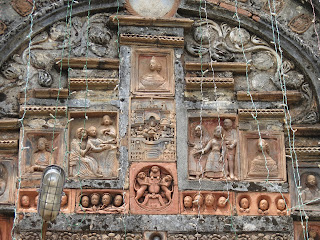There is lot of
controversies on the significance of name ‘Birbhum’, but the most popular of
them is the land (bhum) of Brave people (Bir). Certainly after hearing that one
will be curious to find evidences from history in support of that explanation. We
do not know whether Birbhum got his name from the gallantry of the kings but
their opulence made them significant in the history of Birbhum. Hetampur Raj
was one of them and the terracotta temples are built under their kingship left
interesting spots.
Hetampur gets
its name from a local zamindar Hetam Khan and the Hetampur raj arose from an
unskilled worker of Bankura District to the most powerful family of Birbhum.
Radhanath Chakraborty was the first prominent name of Hetampur Royal family who
subdued the former Gomastas and Iajardars. By the end of 18th
century more lands of Birbhum were taken by them. Even they declared themselves
as independent kings and refused to pay tax to Nawab of Murshidabad anymore.
Such influence was carried out by this family even after Radhanath Chakraborty.
Both Hetampur
royal palace and nearby terracotta temples are the reflections of their
opulence. The royal palace has a big red gateway. This gateway has interesting
female figures on the top of it. Such figures are very rare with respect to
other structures of Birbhum as it this is prone to Roman classical style. It
would not be wrong to say that such Roman classical style was transmitted to
this region through Victorian architecture. This indicates their relation with
British culture and the implication of that style in various parts of royal
palace and terracotta temples signify their association with British
administration.
Unlike the other terracotta temples this temple bore mostly European figures. Though there are figures like Mahisashurmardini Durga, but such figure is rare particularly in this temple. The image of court of arms of British East India Company, male figure with hat, coat and trouser, a lady dressed in gowns are demonstrating the British influence upon the royal family. This is beyond doubt that such representation of British culture and power did not have any influence on rural society.
Though it is hard to tell whether presence of English women were irregular in this area at the time when this temple was constructed but it would not be wrong to say that those memsahibs were not very irregular in the rural landscape of Colonial India. Many of them came here to live with their male counterparts in the bungalows and residences. Representation of the late Victorian women is clear on the temple walls.
On the other hand we have female figure as a companion of English male figure. Story which evolves around this illustration is rather a story of a sexual relation. This sexual relation evolves around a native women and an English man. It would not be wrong to say that this native woman is a prostitute who was a matter of concern from British army barracks to the board of control of Company. By addressing that history terracotta art did a first-class job. So it can be said that art on this temple is rather a portrayal of colonial life in India rather than rural cults and myths.
Unlike other
places of Birbhum Hetampur does not have much treasure in its box. Those, which
are alive, are not in a better position except some of them. One of them is
Dewanji temple which is situated close to the previous one. This is a traditional
Deul structure and it has figures of musicians playing the instruments like khol and blowing horn. God and Goddess are the most common figures of this
temple. Apart from that we have various other figures like musicians, maids,
dancers. Both Vishnu and Krishna are depicted in this temple. Vishnu is seen
with Lakshmi and Krishna is accompanied by gopis and Radha. Probably this
temple was dedicated to Vishnu or Krishna.
References
1. Temple
Terracottas of Birbhum, Mukul Dey.
2. Mukul
Dey archives. Chitralekha
3. The
Economic life of Bengal district 1770-1857, Dr. Ranjan Kumar Gupta, 1984.
4. West Bengal District Gazetteers : Birbhum by L.S.S.
O’Malley & Durgadas Majumder (1973).
5. “Birbhum Bibaran” by Mahima Niranjan Chakraborty .
Research - Santanu Roy.
Picture Courtesy - Sritam Mukherjee.
Research - Santanu Roy.
Picture Courtesy - Sritam Mukherjee.






















2 comments:
beautiful post
Beautiful post
Post a Comment